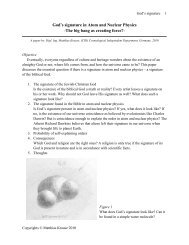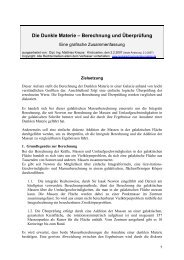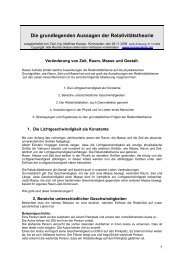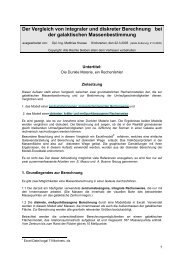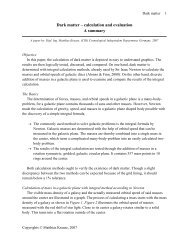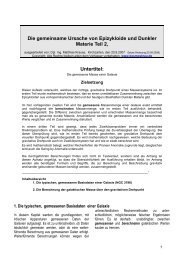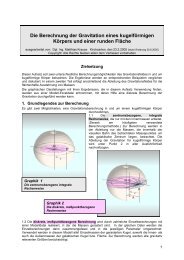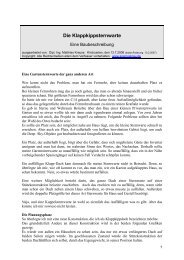Calculation of gravitational forces of a sphere and ... - Dunkle-Materie
Calculation of gravitational forces of a sphere and ... - Dunkle-Materie
Calculation of gravitational forces of a sphere and ... - Dunkle-Materie
You also want an ePaper? Increase the reach of your titles
YUMPU automatically turns print PDFs into web optimized ePapers that Google loves.
Copyrights © Matthias Krause, 2005<br />
Sphere <strong>and</strong> plane 8<br />
point is to underst<strong>and</strong> that the <strong>gravitational</strong> characteristics <strong>of</strong> a homogenous <strong>sphere</strong><br />
depend on the distance <strong>of</strong> P to the <strong>sphere</strong>’s center. The solution <strong>of</strong> any other problems<br />
pertaining to gravity calculation is <strong>of</strong>ten a symmetry adjustment. Such a simplification<br />
usually turns the issue into an easy to solve math problem.<br />
Alonso <strong>and</strong> Finn’s conclusion<br />
The purpose <strong>of</strong> these calculations <strong>and</strong> derivations is to see if the formulas for<br />
<strong>gravitational</strong> <strong>forces</strong> apply to point masses as well as masses with a larger volume.<br />
All formulas pertaining to the calculation <strong>of</strong> <strong>gravitational</strong> <strong>forces</strong> are valid for<br />
point masses <strong>and</strong> masses with volume – under specific circumstances. Spheres<br />
can be used as point masses if only the masses within the orbit <strong>of</strong> P are<br />
considered. The masses beyond this orbit shall not be used. In addition, a <strong>sphere</strong><br />
has to be rotation symmetrical.<br />
Hence, m <strong>and</strong> r are known variables <strong>and</strong> can be used to determine F.<br />
Derivation <strong>of</strong> gravity with the measuring point-oriented discrete calculation method<br />
When calculating discretely, a few fundamental evaluations can provide new insight <strong>and</strong><br />
underst<strong>and</strong>ing <strong>of</strong> <strong>gravitational</strong> <strong>forces</strong>. Alonso <strong>and</strong> Fin (2000) introduced two <strong>of</strong> their results,<br />
which have been summarized on the last four pages:<br />
1. In the center <strong>of</strong> a point symmetrical, solid, homogenous <strong>sphere</strong> gravity is not noticeable.<br />
2. As long as the masses on the surface <strong>of</strong> a hollow <strong>sphere</strong> are distributed evenly, the<br />
gravity on the inside is equal to zero.<br />
What happens when the masses are not symmetrical?<br />
1. Gravity in the center <strong>of</strong> a point symmetrical <strong>sphere</strong><br />
The ideal solid <strong>sphere</strong><br />
center<br />
Figure 9<br />
A point P is located in the center <strong>of</strong> a point<br />
symmetrical <strong>sphere</strong> shaped body. The mass<br />
distribution is even. The <strong>gravitational</strong> <strong>forces</strong> <strong>of</strong><br />
the surrounding masses counteract each other,<br />
as long as they have the same distance from the<br />
center <strong>and</strong> are exactly opposite each other.<br />
Consequently, the gravity in the center is<br />
completely cancelled out.




